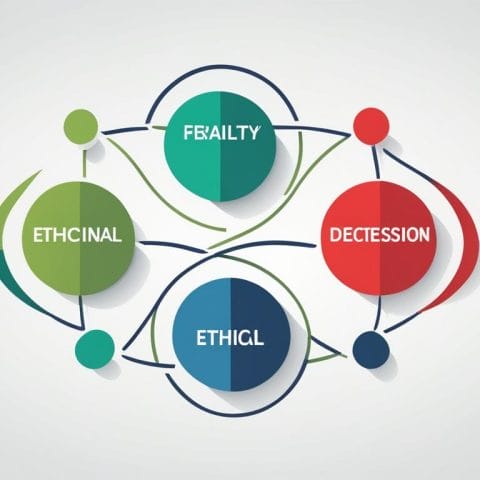Did you know that organizations spend an estimated $8 billion annually on diversity training in the United States alone? With the growing importance of diversity and inclusion in the workplace, companies are investing significant resources to educate their employees and foster inclusive cultures.
In this guide, we’ll explore the factors that influence the cost of diversity training, from program duration and customization to additional services. We’ll also highlight some of the top diversity and inclusion training programs available and provide insights on developing effective DE&I training initiatives. Whether you’re a small business or a large corporation, this guide will help you navigate the world of diversity training and make informed decisions for your organization’s diversity and inclusion initiatives.
Key Takeaways:
- Organizations in the US spend approximately $8 billion annually on diversity training.
- Factors such as program duration and customization influence the cost of diversity training.
- There are various top diversity and inclusion training programs available.
- Effective DE&I training requires careful planning and customization.
- Maintaining and extending DE&I training is crucial for long-term success.
Learn more about the importance of diversity training
Top Diversity and Inclusion Training Programs
When it comes to diversity and inclusion training, there are several top-notch programs available. These programs offer a range of topics and approaches to help organizations foster inclusivity and diversity in the workplace.
Diversity, Equity, and Inclusion Certificate Program by eCornell
The Diversity, Equity, and Inclusion Certificate Program offered by eCornell is designed to provide comprehensive training on creating and maintaining an inclusive work environment. This program covers topics such as bias awareness, cultural competence, and creating inclusive policies and practices.
Diversity Works by HRDQ
Diversity Works is a program developed by HRDQ that focuses on understanding and appreciating diversity in the workplace. It offers a variety of learning activities and exercises to help participants develop awareness, empathy, and communication skills.
Equality, Diversity & Inclusion (EDI) Training by iHasco
The Equality, Diversity & Inclusion (EDI) Training from iHasco is an interactive online training program that covers a wide range of diversity and inclusion topics. Participants learn about equality legislation, unconscious bias, and promoting inclusivity within the workplace.
Unconscious Bias by Microsoft
Unconscious Bias is a training program developed by Microsoft that focuses on exploring and addressing unconscious biases that can impact decision-making and relationships in the workplace. The program provides strategies for creating a more inclusive and equitable work environment.
Diversity and Inclusion in the Workplace – Essential Concepts by Compliance Training Group
The Diversity and Inclusion in the Workplace – Essential Concepts program offered by Compliance Training Group provides participants with a foundational understanding of diversity and inclusion. It covers key topics such as cultural competence, microaggressions, and fostering an inclusive workplace culture.
Respect Gender & Sexual Differences & Assert Yourself by Eleventure Team
The Respect Gender & Sexual Differences & Assert Yourself training program by Eleventure Team focuses on promoting inclusivity and respect for gender and sexual differences in the workplace. It offers practical strategies for fostering an inclusive environment where individuals feel comfortable being their authentic selves.
Ethical Work Culture Training Course by ProProfs Diversity Training
The Ethical Work Culture Training Course from ProProfs Diversity Training is designed to educate participants on ethical practices in the workplace. It covers important topics such as workplace harassment, discrimination, and creating a culture of respect and inclusion.
Diversity and Inclusion Certification Course by HR University
The Diversity and Inclusion Certification Course offered by HR University provides participants with a comprehensive understanding of diversity and inclusion concepts. It covers topics such as unconscious bias, inclusive leadership, and strategies for creating diverse and inclusive teams.
These are just a few examples of the top diversity and inclusion training programs available. Each program offers unique insights and approaches to help organizations develop a more inclusive and diverse workplace. To learn more about why diversity and inclusion training is important, check out this resource.
Understanding DE&I Training Programs

DE&I training programs are designed to address biases and prejudices in the workplace, fostering diversity and inclusivity within organizations. These programs tackle a range of issues and are aligned with the company’s mission to drive overall improvements. Inclusive communication plays a crucial role, as it enables effective collaboration and empowers individuals from diverse backgrounds to contribute their unique perspectives.
One of the primary objectives of DE&I training programs is to uncover and identify unconscious biases that may exist within the organization. By raising awareness about these biases, organizations can work towards eliminating them, creating a more inclusive work environment for everyone. In addition, addressing microaggressions and promoting respectful communication helps to foster a culture of fairness and equitable treatment.
Through DE&I training programs, companies can enhance cultural competency among their employees, enabling them to navigate diverse workplaces with sensitivity and respect. These programs provide participants with the knowledge and tools to understand different cultures, perspectives, and experiences, promoting understanding and positive interaction.
By engaging in DE&I training, organizations communicate their commitment to fostering a diverse and inclusive workforce. This commitment not only attracts diverse talent but also helps companies retain their employees by creating an environment where everyone feels valued and respected.
“DE&I training facilitates open and honest conversations about diversity, equity, and inclusion within organizations. It empowers employees to challenge their own biases and actively contribute to a more inclusive workplace.” – Mark Johnson, Chief Diversity Officer at Diversity Matters Inc.
Benefits of DE&I Training Programs
- Greater employee engagement and satisfaction
- Improved collaboration and teamwork
- Enhanced problem-solving and decision-making
- Innovation and creativity through diverse perspectives
- Stronger relationships with clients and customers from diverse backgrounds
DE&I training programs go beyond raising awareness and promoting understanding; they also provide individuals with actionable strategies for creating inclusive work environments. These strategies range from promoting diverse hiring practices and inclusive leadership to establishing employee resource groups and mentoring programs.
Overall, DE&I training programs contribute to building a more equitable and inclusive society by fostering understanding, embracing diversity, and promoting respectful and inclusive communication in workplaces across industries.
Keys to Developing a DE&I Training Program
Developing a successful DE&I training program requires responsible planning and a clear understanding of the program’s objectives. It is crucial to create a training program that addresses a range of issues and effectively promotes diversity, equity, and inclusion within the organization.
When creating a DE&I training program, it is important to align it with the company’s mission and core values. This ensures that the training is integrated into the overall organizational culture and reinforces an inclusive environment.
Responsible training planning involves considering the diverse needs and backgrounds of employees and tailoring the program accordingly. This includes incorporating interactive elements, real-life examples, and case studies that resonate with participants.
In addition, the program should cover a wide range of DE&I topics, such as unconscious bias, inclusive communication, and creating an equitable workplace. This comprehensive approach ensures that participants gain a holistic understanding of diversity and inclusion and can apply their learnings effectively in their roles.
Another key aspect of successful DE&I training is the involvement and support of leadership. Leadership buy-in helps promote a positive and supportive culture, encouraging employees to actively participate in the training and embrace the principles of diversity and inclusion.
Table: Factors to Consider in Developing a DE&I Training Program
| Factors | Explanation |
|---|---|
| Clear objectives | Define the desired outcomes and purpose of the training program. |
| Comprehensive topics | Cover a wide range of DE&I topics to ensure a holistic understanding. |
| Alignment with company culture | Tie the training program to the organization’s mission and core values. |
| Diverse training methods | Incorporate interactive elements, case studies, and real-life examples. |
| Leadership support | Gain buy-in from leadership to foster a positive and supportive culture. |
By considering these key factors and tailoring the DE&I training program to the unique needs of the organization, companies can develop a comprehensive and successful training program that fosters diversity, equity, and inclusion.
Extending and Maintaining DE&I Training
While DE&I training can have significant short-term effects on employees’ knowledge and attitudes, it is imperative to consider the long-term impact and sustainability of such training programs. Maintaining the momentum and extending the reach of DE&I training requires a strategic approach that goes beyond a one-time event.
To ensure long-term success and continued growth in diversity and inclusion, organizations need to deliver DE&I training consistently and make it an integral part of their company culture. By integrating the principles of diversity and inclusion into everyday practices and policies, companies can create an environment that fosters equity and embraces diverse perspectives.
Regular reinforcement of DE&I training is crucial to prevent regression and sustain positive behavior change. This involves providing ongoing support, resources, and opportunities for employees to apply what they have learned in their day-to-day work.
| Strategies for Extending and Maintaining DE&I Training |
|---|
| 1. Continuous Education: Offer ongoing learning opportunities such as workshops, webinars, or discussion sessions to deepen employees’ understanding of diversity and inclusion topics. |
| 2. Leadership Engagement: Ensure that leaders actively support and champion diversity and inclusion efforts, setting the tone for the entire organization. |
| 3. Employee Resource Groups (ERGs): Encourage the formation of ERGs to provide a space where employees can connect, share experiences, and collaborate on diversity and inclusion initiatives. |
| 4. Metrics and Accountability: Establish metrics to measure the impact of DE&I training and regularly track progress. Hold leaders and employees accountable for creating an inclusive workplace. |
| 5. Inclusive Policies and Practices: Review and update company policies and practices to ensure they align with the principles of diversity and inclusion. |
By following these strategies, organizations can create a sustainable culture of diversity and inclusion. Continuous education, active leadership engagement, the support of ERGs, monitoring progress through metrics, and fostering inclusive policies and practices all contribute to extending and maintaining the impact of DE&I training.
Remember, DE&I training is not a one-time solution but an ongoing commitment to creating an inclusive and equitable workplace.
Tailoring DE&I Training to Your Company
Implementing effective DE&I training requires a tailored approach that considers the unique objectives and challenges of each organization. By customizing training programs, companies can enhance their diversity and inclusion initiatives and create a more inclusive work environment.
Conducting Assessments
Before designing a DE&I training program, it’s essential to conduct assessments to gain a thorough understanding of the organization’s current diversity and inclusion landscape. These assessments help identify areas for improvement and provide insights into specific topics that should be addressed during the training.
“Conducting assessments allows organizations to gain valuable insights into their diversity and inclusion landscape, enabling them to tailor training programs that address specific challenges.”
Utilizing Professional Help
Creating tailor-made DE&I training programs can be a complex task. To ensure the training effectively addresses the organization’s goals and needs, it’s beneficial to seek professional help from experts in the field. These professionals have the knowledge and experience to design and deliver customized training programs that resonate with employees and drive meaningful change.
Using Real-Life Examples
A successful DE&I training program incorporates real-life examples relevant to the organization. By using case studies, scenarios, or stories that reflect the company’s industry or experiences, employees can better relate to the training content. This approach enhances engagement, deepens understanding, and encourages the application of diversity and inclusion principles in real-world situations.
Overall, tailoring DE&I training to your company ensures a more targeted and impactful approach. By conducting assessments, utilizing professional help, and using real-life examples, organizations can create customized training programs that foster a more inclusive and equitable workplace.
Planning an Integrated Approach to DE&I Training

Developing a successful diversity, equity, and inclusion (DE&I) training program requires an integrated approach that utilizes various instruction methods. By incorporating a range of techniques, such as lectures, discussions, and interactive exercises, organizations can ensure that their employees respond favorably and retain the valuable information learned.
One effective method is to incorporate lectures that provide foundational knowledge on DE&I topics, allowing participants to gain a comprehensive understanding of key concepts. These lectures can be augmented with thought-provoking discussions, allowing for the exchange of ideas and perspectives. Encouraging participants to share their experiences and insights fosters a sense of inclusivity and empathy.
Another important instructional method is the use of exercises and activities that engage employees in hands-on learning. These activities can include scenario-based simulations, role-playing exercises, and group projects. By actively participating in these exercises, employees gain a deeper understanding of DE&I principles and learn how to apply them in real-life situations.
Creating a Series of Related Initiatives
In addition to utilizing different instruction methods, it is crucial to create a series of related initiatives that reinforce the DE&I training. This can include ongoing workshops, webinars, and seminars that delve deeper into specific DE&I topics. By offering a continuum of learning opportunities, organizations can ensure that employees continue to build upon their knowledge and skills.
A comprehensive approach also involves ingraining diversity and inclusion into the fabric of the company’s culture. This can be achieved by establishing clear policies and practices that promote and support DE&I principles. It is important to involve employees at all levels in the implementation of these policies, fostering a sense of ownership and commitment to the organization’s DE&I initiatives.
Retaining the Training and Building a Culture of Inclusion
Successful DE&I training goes beyond a one-time event; it requires long-term commitment and effort. To ensure the retention of knowledge and behavior change, organizations should periodically review and reinforce the training. This can be done through refresher courses, ongoing discussions, and continuous education on emerging DE&I trends.
An effective way to embed diversity and inclusion within company culture is to integrate DE&I principles into everyday practices and processes. This can include revising recruitment and hiring strategies to attract a diverse pool of candidates, promoting inclusive communication and collaboration, and providing ongoing support and resources for employee development.
This image highlights the importance of a successful DE&I training program in creating an inclusive and diverse workplace.
By planning an integrated approach to DE&I training, organizations can foster an environment that values diversity and promotes inclusion. Incorporating various instruction methods, creating a series of related initiatives, and ingraining DE&I principles into the company culture are key elements of a successful and impactful training program.
DE&I Training Fees and Policies
When considering diversity, equity, and inclusion (DE&I) training programs, it is essential to understand the associated fees and policies. The cost of DE&I training can vary depending on several factors.
Workshop Delivery and Customization
DE&I training fees are influenced by the chosen workshop delivery method. In-person workshops, virtual sessions, or a combination of both can impact pricing. Additionally, customization options tailored to your organization’s specific needs may incur additional costs. Custom workshops allow you to address unique challenges and align the training content with your company’s culture.
Keynote Presentations and Additional Participants
If you are considering a keynote presentation by an industry expert, the fees may differ from standard workshop rates. Keynote presentations often provide valuable insights and inspiration to a larger audience, making them an excellent choice for conferences or company-wide events. Additionally, the number of participants attending the training can affect pricing. Organizations may incur additional charges for larger groups.
Handouts, Materials, and Consultations
DE&I training programs frequently include handouts and materials to enhance learning and provide ongoing support. These resources, such as workbooks or digital materials, contribute to the overall cost of the training. Furthermore, consultations with trainers and experts for program design and implementation may involve separate fees.
Cancellation Policies and Reduced Fees
It is important to familiarize yourself with the cancellation policies of DE&I training providers. Cancellation charges may apply if the training is canceled within a certain timeframe. However, some providers offer flexibility and may provide partial or full refunds under specific conditions.
For organizations with limited budgets, reduced fees or discounts may be available. Many DE&I training providers offer scaled pricing options to accommodate different financial capacities while ensuring equal access to training opportunities.
By understanding the fees and policies associated with DE&I training, organizations can make informed decisions that align with their training needs, objectives, and budget.
Open Public Workshop Fees and Policies

When it comes to open public workshop fees, the costs are determined based on the event and administrative costs. Diversity Essentials and other third-party organizations offer a range of workshops designed to educate individuals and organizations on diversity and inclusion topics. These workshops provide valuable insights, strategies, and resources for attendees to implement in their workplaces.
Registration fees for open public workshops may vary depending on the workshop duration, content, and expertise of the facilitators. It is important to consider the value that these workshops can provide in terms of professional development, increased awareness, and actionable strategies. Investing in these workshops can contribute to fostering an inclusive and equitable workplace culture.
When registering for a workshop, it is crucial to review the cancellation policy. Policies may vary depending on the specific workshop and organizer. Refunds for cancellations are typically offered within a specific time frame, with refund percentages ranging from 25% to 100% based on certain conditions. Reviewing the cancellation policy in advance allows participants to make informed decisions and plan accordingly.
Attending open public workshops offers the opportunity to learn from industry experts, connect with like-minded individuals, and gain valuable insights into diversity and inclusion topics. These workshops provide a structured and interactive learning experience that can enhance individual and organizational strategies for building inclusive environments.
Open Public Workshop Fees and Cancellation Policy
| Workshop | Fee | Cancellation Policy |
|---|---|---|
| Diversity and Inclusion Essentials Workshop | $250 per participant | Refunds available up to 7 days before the workshop date |
| Advanced DE&I Strategies Workshop | $500 per participant | Refunds available up to 14 days before the workshop date |
| Inclusive Leadership Workshop | $350 per participant | No refunds available |
Resources:
Explore the following open public workshops offered by Diversity Essentials:
- Workshop 1: Building Inclusive Teams
- Workshop 2: Unconscious Bias in the Workplace
- Workshop 3: Creating an Inclusive Company Culture
Travel, Accommodations, and Additional Considerations
When organizing DE&I training outside of city limits, host organizations are responsible for providing reasonable travel and accommodations for trainers. These arrangements ensure that trainers can focus on delivering high-quality training without any logistical concerns.
In addition to travel and accommodations, there are other important considerations to keep in mind when planning DE&I training. These considerations may include room rentals, print costs, and licensing fees.
Travel and Accommodations
Providing comfortable and convenient travel and accommodations is essential for trainers to perform their best during training sessions. This may include arranging flights, booking hotel rooms, and, if necessary, arranging transportation to and from the training venue.
By making travel and accommodations a priority, host organizations demonstrate their commitment to the success of the DE&I training program. It also fosters a positive environment for trainers, enabling them to deliver impactful training experiences.
Additional Considerations
In addition to the primary expenses of travel and accommodations, there are other considerations that may arise when planning DE&I training.
“Room rentals, print costs, and licensing fees are some additional factors that organizations should take into account for a comprehensive training program.”
Room rentals may be necessary if the organization’s premises cannot accommodate the training group. Renting a suitable training venue ensures a conducive learning environment for participants.
Print costs may arise if training materials need to be provided in hard copy format. This includes manuals, handouts, and any other resources that enhance the learning experience.
Licensing fees may apply if the training incorporates copyrighted materials or utilizes specific software or tools. It is important to obtain the necessary licenses to ensure compliance and protect intellectual property rights.
Planning and communicating these arrangements in advance is crucial to ensure a smooth training experience. By considering all these additional factors, host organizations can ensure that the DE&I training program is comprehensive and effective.
Responsive Planning for Success
By being proactive and responsive in planning travel, accommodations, and additional considerations, organizations can create an environment that fosters successful DE&I training experiences.
Open communication with trainers, understanding their needs, and addressing any concerns enables a collaborative approach to planning. It is also essential to have clear policies and procedures in place to minimize any potential delays or misunderstandings.
Ultimately, creating a well-planned and supportive environment allows trainers and participants to fully engage in the DE&I training program, promoting inclusive workplace practices and driving positive change.
| Travel and Accommodations | Additional Considerations |
|---|---|
| Provides comfort and convenience for trainers | Sets budgets for room rentals, print costs, and licensing fees |
| Allows trainers to focus on training delivery | Ensures a conducive learning environment |
| Elevates the overall training experience | Provides necessary training materials in hard copy |
| Supports the success of the DE&I training program | Obtains necessary licenses for copyrighted materials or software |
| Fosters a positive environment for trainers | Proactively plans and communicates arrangements |
Conclusion
Diversity and inclusion training programs play a vital role in creating inclusive and diverse workplaces. These programs educate organizations on the importance of diversity, equity, and inclusion, fostering an inclusive company culture and repelling bias.
The cost of these programs varies based on factors such as program duration, customization, and additional services. Organizations should carefully consider their training needs, goals, and budget to find the best fit for their diversity and inclusion initiatives.
By investing in diversity and inclusion training, organizations can empower their employees with the knowledge and skills needed to foster a diverse and inclusive environment. This not only enhances employee engagement and productivity but also strengthens the company’s reputation as a diverse and inclusive employer.
FAQ
How much does diversity training cost?
The cost of diversity training can vary depending on factors such as the duration of the program, customization, and additional services. It is best to contact training providers directly for pricing information.
What are the factors that affect the cost of diversity training?
Factors that can impact the cost of diversity training include workshop delivery, custom workshops, keynote presentations, and the number of participants. Additional costs may include handouts, materials, and consultations.
Are there affordable diversity training options available?
Yes, there are affordable diversity training options available. Some organizations offer free or low-cost programs, while others provide discounts or reduced fees for organizations with limited budgets.
Which are the top diversity and inclusion training programs?
Some of the top diversity and inclusion training programs include the Diversity, Equity, and Inclusion Certificate Program by eCornell, Diversity Works by HRDQ, Equality, Diversity & Inclusion (EDI) Training by iHasco, Unconscious Bias by Microsoft, Diversity, Equity, and Inclusion Certificate Program by AMA, Diversity and Inclusion in the Workplace – Essential Concepts by Compliance Training Group, Respect Gender & Sexual Differences & Assert Yourself by Eleventure Team, Ethical Work Culture Training Course by ProProfs Diversity Training, and Diversity and Inclusion Certification Course by HR University.
What do DE&I training programs aim to achieve?
DE&I training programs aim to educate organizations on the importance of diversity, equity, and inclusion, raise awareness of legislation and best practices, and create an inclusive company culture that repels bias.
What topics are covered in DE&I training?
DE&I training programs should cover a range of issues, including unconscious bias, microaggressions, inclusive communication, and addressing biases or prejudices in the workplace.
How can organizations develop a successful DE&I training program?
Developing a successful DE&I training program requires careful planning. It should be based on clear objectives, tied to the company’s mission and core values, and address the unique challenges and needs of the organization.
How can organizations extend and maintain DE&I training?
DE&I training should be delivered consistently over time to ensure long-term success. Reinforcing training regularly and integrating diversity and inclusion into the company’s culture helps combat regression and sustain positive behavior.
Is it possible to tailor DE&I training to each organization?
Yes, DE&I training should be tailored for each organization to address their specific objectives and challenges. Conducting assessments, utilizing professional help, and using real-life examples specific to the company can enhance the effectiveness of the training.
What is the recommended approach for planning DE&I training?
Planning an integrated approach to DE&I training involves using various instruction methods such as lectures, discussions, and exercises. Creating a series of related initiatives and ingraining diversity and inclusion into the fabric of the company reinforces the training and makes it a part of the company’s culture.
What are the fees for DE&I training?
DE&I training fees vary based on factors such as workshop delivery, custom workshops, keynote presentations, and additional participants. Fees are typically billed per 60 minutes and may include costs for handouts, materials, and consultations. Cancellation policies may apply, and reduced fees are often available for organizations with limited budgets.
How are fees determined for open public workshops?
Open public workshop fees hosted by Diversity Essentials or third-party organizations are determined based on the event and administrative costs. Cancellation policies vary, and refunds may be given based on certain conditions and timing of the cancellation.
What additional considerations should be made for DE&I training?
Host organizations are responsible for providing reasonable travel and accommodations for trainers outside of city limits. Additional considerations like room rentals, print costs, and licensing fees may apply. It is important to plan and communicate these arrangements in advance to ensure a smooth training experience.





